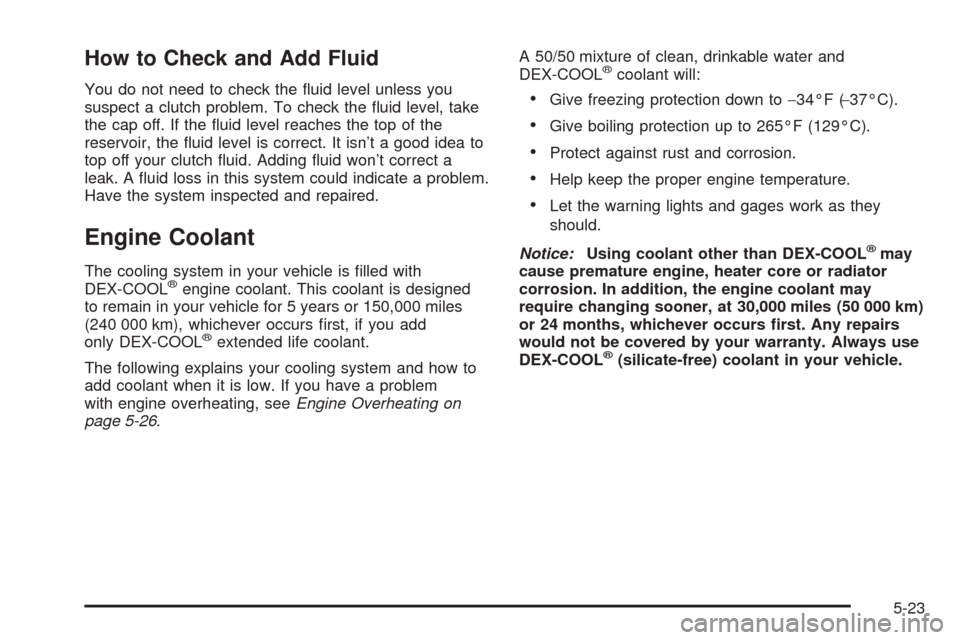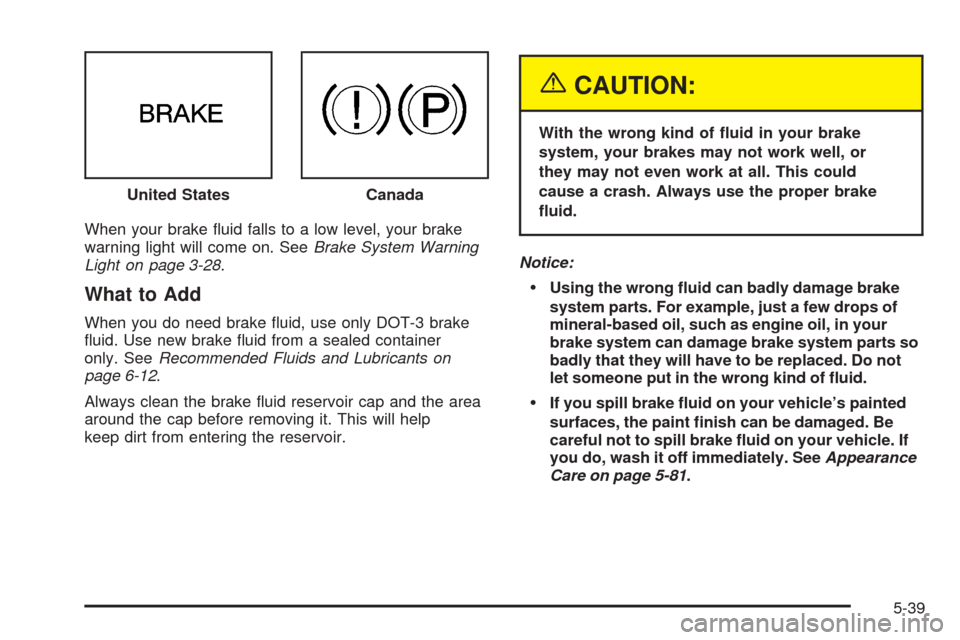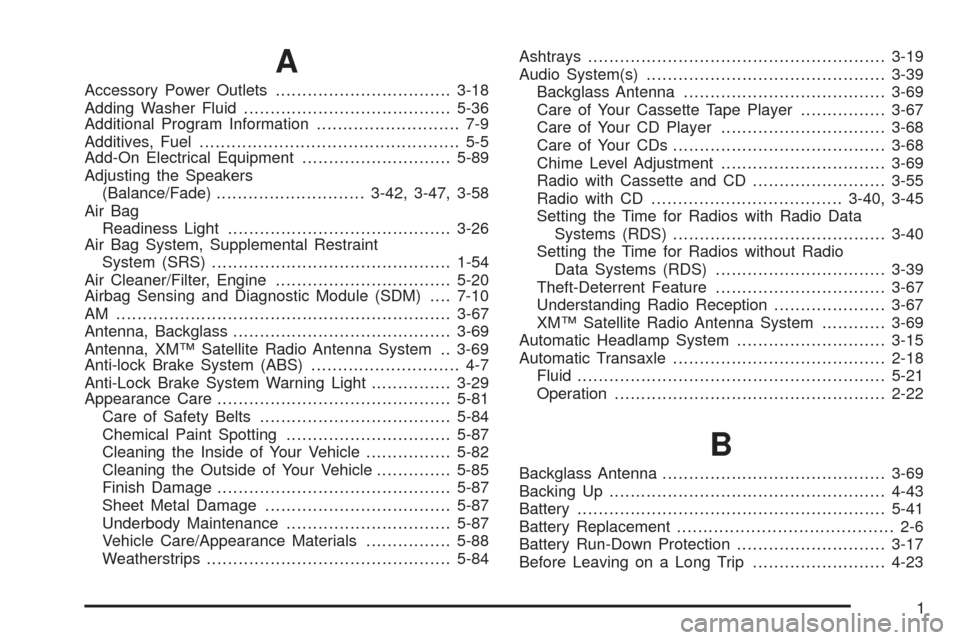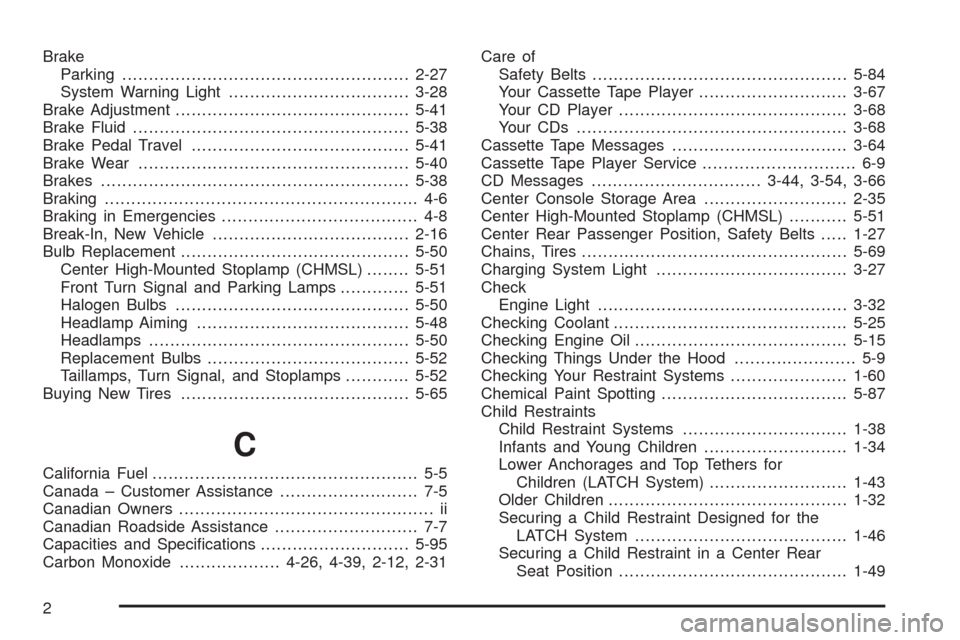warning light Oldsmobile Alero 2004 s Owner's Guide
[x] Cancel search | Manufacturer: OLDSMOBILE, Model Year: 2004, Model line: Alero, Model: Oldsmobile Alero 2004Pages: 360, PDF Size: 2.49 MB
Page 243 of 360

How to Check and Add Fluid
You do not need to check the fluid level unless you
suspect a clutch problem. To check the fluid level, take
the cap off. If the fluid level reaches the top of the
reservoir, the fluid level is correct. It isn’t a good idea to
top off your clutch fluid. Adding fluid won’t correct a
leak. A fluid loss in this system could indicate a problem.
Have the system inspected and repaired.
Engine Coolant
The cooling system in your vehicle is filled with
DEX-COOL®engine coolant. This coolant is designed
to remain in your vehicle for 5 years or 150,000 miles
(240 000 km), whichever occurs first, if you add
only DEX-COOL
®extended life coolant.
The following explains your cooling system and how to
add coolant when it is low. If you have a problem
with engine overheating, seeEngine Overheating on
page 5-26.A 50/50 mixture of clean, drinkable water and
DEX-COOL
®coolant will:
•Give freezing protection down to−34°F (−37°C).
•Give boiling protection up to 265°F (129°C).
•Protect against rust and corrosion.
•Help keep the proper engine temperature.
•Let the warning lights and gages work as they
should.
Notice:Using coolant other than DEX-COOL
®may
cause premature engine, heater core or radiator
corrosion. In addition, the engine coolant may
require changing sooner, at 30,000 miles (50 000 km)
or 24 months, whichever occurs �rst. Any repairs
would not be covered by your warranty. Always use
DEX-COOL
®(silicate-free) coolant in your vehicle.
5-23
Page 246 of 360

The vehicle must be on a level surface. When your
engine is cold, the coolant level should be at the FULL
COLD mark, or a little higher.
If the low coolant light
comes on and stays on, it
means you’re low on
engine coolant.
SeeLow Coolant Warning Light on page 3-32for more
information.
Adding Coolant
If you need more coolant, add the proper DEX-COOL®
coolant mixtureat the surge tank, but only when the
engine is cool. If the surge tank is empty, a special fill
procedure is necessary. SeeEngine Overheating
on page 5-26and “How to Add Coolant to the Coolant
Surge Tank” underCooling System on page 5-29
for instructions.
{CAUTION:
You can be burned if you spill coolant on hot
engine parts. Coolant contains ethylene glycol,
and it will burn if the engine parts are hot
enough. Don’t spill coolant on a hot engine.
When replacing the pressure cap, make sure it is
hand-tight.
Engine Overheating
You will find a coolant temperature gage and a low
coolant warning light on your vehicle’s instrument panel.
SeeEngine Coolant Temperature Gage on page 3-31
andLow Coolant Warning Light on page 3-32.
5-26
Page 248 of 360

If No Steam Is Coming From Your
Engine
An overheat warning, along with a low coolant light, can
indicate a serious problem. SeeLow Coolant Warning
Light on page 3-32.
If you get an engine overheat warning with no low
coolant light, but see or hear no steam, the problem may
not be too serious. Sometimes the engine can get a
little too hot when you:
•Climb a long hill on a hot day.
•Stop after high-speed driving.
•Idle for long periods in traffic.
•Tow a trailer.If you get the overheat warning with no sign of steam,
try this for a minute or so:
1. In heavy traffic, let the engine idle in NEUTRAL (N)
while stopped. If it is safe to do so, pull off the road,
shift to PARK (P) or NEUTRAL (N) and let the
engine idle.
2. Turn on your heater to full hot at the highest fan
speed and open the window as necessary.
If you no longer have the overheat warning, you can
drive. Just to be safe, drive slower for about 10 minutes.
If the warning doesn’t come back on, you can drive
normally.
If the warning continues, pull over, stop, and park your
vehicle right away.
If there’s still no sign of steam, you can idle the engine
for three minutes while you’re parked. If you still
have the warning,turn off the engine and get everyone
out of the vehicleuntil it cools down.
You may decide not to lift the hood but to get service
help right away.
5-28
Page 256 of 360

How to Check Power Steering Fluid
Turn the key off, let the engine compartment cool down,
wipe the cap and the top of the reservoir clean, then
unscrew the cap and wipe the dipstick with a clean rag.
Replace the cap and completely tighten it. Then remove
the cap again and look at the fluid level on the dipstick.
The level should be at the FULL COLD mark. If
necessary, add only enough fluid to bring the level up to
the mark.
What to Use
To determine what kind of fluid to use, see
Recommended Fluids and Lubricants on page 6-12.
Always use the proper fluid. Failure to use the proper
fluid can cause leaks and damage hoses and seals.
Windshield Washer Fluid
What to Use
When you need windshield washer fluid, be sure to read
the manufacturer’s instructions before use. If you will
be operating your vehicle in an area where the
temperature may fall below freezing, use a fluid that has
sufficient protection against freezing. SeeEngine
Compartment Overview on page 5-12for reservoir
location.
Adding Washer Fluid
Your vehicle has a low
washer fluid telltale that
will come on in the
instrument panel cluster
when the washer fluid
is low.
SeeLow Washer Fluid Warning Light on page 3-37for
more information.
5-36
Page 259 of 360

When your brake fluid falls to a low level, your brake
warning light will come on. SeeBrake System Warning
Light on page 3-28.
What to Add
When you do need brake fluid, use only DOT-3 brake
fluid. Use new brake fluid from a sealed container
only. SeeRecommended Fluids and Lubricants on
page 6-12.
Always clean the brake fluid reservoir cap and the area
around the cap before removing it. This will help
keep dirt from entering the reservoir.
{CAUTION:
With the wrong kind of �uid in your brake
system, your brakes may not work well, or
they may not even work at all. This could
cause a crash. Always use the proper brake
�uid.
Notice:
Using the wrong �uid can badly damage brake
system parts. For example, just a few drops of
mineral-based oil, such as engine oil, in your
brake system can damage brake system parts so
badly that they will have to be replaced. Do not
let someone put in the wrong kind of �uid.
If you spill brake �uid on your vehicle’s painted
surfaces, the paint �nish can be damaged. Be
careful not to spill brake �uid on your vehicle. If
you do, wash it off immediately. SeeAppearance
Care on page 5-81. United States
Canada
5-39
Page 260 of 360

Brake Wear
Disc brake pads have built-in wear indicators that make
a high-pitched warning sound when the brake pads
are worn and new pads are needed. The sound
may come and go or be heard all the time your vehicle
is moving (except when you are pushing on the
brake pedal firmly).
{CAUTION:
The brake wear warning sound means that
soon your brakes will not work well. That
could lead to an accident. When you hear the
brake wear warning sound, have your vehicle
serviced.Notice:Continuing to drive with worn-out brake
pads could result in costly brake repair.
Some driving conditions or climates may cause a brake
squeal when the brakes are first applied or lightly
applied. This does not mean something is wrong with
your brakes.
Properly torqued wheel nuts are necessary to help
prevent brake pulsation. When tires are rotated, inspect
brake pads for wear and evenly tighten wheel nuts in
the proper sequence to GM torque specifications.
If you have rear drum brakes, they do not have wear
indicators, but if you ever hear a rear brake rubbing
noise, have the rear brake linings inspected immediately.
Also, the rear brake drums should be removed and
inspected each time the tires are removed for rotation or
changing. When you have the front brake pads
replaced, have the rear brakes inspected, too.
Brake linings should always be replaced as complete
axle sets.
5-40
Page 286 of 360

Uniform Tire Quality Grading
Quality grades can be found where applicable on the
tire sidewall between tread shoulder and maximum
section width. For example:
Treadwear 200 Traction AA Temperature A
The following information relates to the system
developed by the United States National Highway
Traffic Safety Administration, which grades tires by
treadwear, traction and temperature performance.
(This applies only to vehicles sold in the United States.)
The grades are molded on the sidewalls of most
passenger car tires. The Uniform Tire Quality Grading
system does not apply to deep tread, winter-type
snow tires, space-saver or temporary use spare tires,
tires with nominal rim diameters of 10 to 12 inches
(25 to 30 cm), or to some limited-production tires.
While the tires available on General Motors passenger
cars and light trucks may vary with respect to these
grades, they must also conform to federal safety
requirements and additional General Motors Tire
Performance Criteria (TPC) standards.
Treadwear
The treadwear grade is a comparative rating based on
the wear rate of the tire when tested under controlled
conditions on a specified government test course.
For example, a tire graded 150 would wear one and
a half (1.5) times as well on the government course as
a tire graded 100. The relative performance of tires
depends upon the actual conditions of their use,
however, and may depart significantly from the norm
due to variations in driving habits, service practices and
differences in road characteristics and climate.
Traction – AA, A, B, C
The traction grades, from highest to lowest, are AA, A,
B, and C. Those grades represent the tire’s ability
to stop on wet pavement as measured under controlled
conditions on specified government test surfaces of
asphalt and concrete. A tire marked C may have poor
traction performance. Warning: The traction grade
assigned to this tire is based on straight-ahead braking
traction tests, and does not include acceleration,
cornering, hydroplaning, or peak traction characteristics.
5-66
Page 347 of 360

A
Accessory Power Outlets.................................3-18
Adding Washer Fluid.......................................5-36
Additional Program Information........................... 7-9
Additives, Fuel................................................. 5-5
Add-On Electrical Equipment............................5-89
Adjusting the Speakers
(Balance/Fade)............................3-42, 3-47, 3-58
Air Bag
Readiness Light..........................................3-26
Air Bag System, Supplemental Restraint
System (SRS).............................................1-54
Air Cleaner/Filter, Engine.................................5-20
Airbag Sensing and Diagnostic Module (SDM)....7-10
AM ...............................................................3-67
Antenna, Backglass.........................................3-69
Antenna, XM™ Satellite Radio Antenna System . . 3-69
Anti-lock Brake System (ABS)............................ 4-7
Anti-Lock Brake System Warning Light...............3-29
Appearance Care............................................5-81
Care of Safety Belts....................................5-84
Chemical Paint Spotting...............................5-87
Cleaning the Inside of Your Vehicle................5-82
Cleaning the Outside of Your Vehicle..............5-85
Finish Damage............................................5-87
Sheet Metal Damage...................................5-87
Underbody Maintenance...............................5-87
Vehicle Care/Appearance Materials................5-88
Weatherstrips..............................................5-84Ashtrays........................................................3-19
Audio System(s).............................................3-39
Backglass Antenna......................................3-69
Care of Your Cassette Tape Player................3-67
Care of Your CD Player...............................3-68
Care of Your CDs........................................3-68
Chime Level Adjustment...............................3-69
Radio with Cassette and CD.........................3-55
Radio with CD....................................3-40, 3-45
Setting the Time for Radios with Radio Data
Systems (RDS)........................................3-40
Setting the Time for Radios without Radio
Data Systems (RDS)................................3-39
Theft-Deterrent Feature................................3-67
Understanding Radio Reception.....................3-67
XM™ Satellite Radio Antenna System............3-69
Automatic Headlamp System............................3-15
Automatic Transaxle........................................2-18
Fluid..........................................................5-21
Operation...................................................2-22
B
Backglass Antenna..........................................3-69
Backing Up....................................................4-43
Battery..........................................................5-41
Battery Replacement......................................... 2-6
Battery Run-Down Protection............................3-17
Before Leaving on a Long Trip.........................4-23
1
Page 348 of 360

Brake
Parking......................................................2-27
System Warning Light..................................3-28
Brake Adjustment............................................5-41
Brake Fluid....................................................5-38
Brake Pedal Travel.........................................5-41
Brake Wear...................................................5-40
Brakes..........................................................5-38
Braking........................................................... 4-6
Braking in Emergencies..................................... 4-8
Break-In, New Vehicle.....................................2-16
Bulb Replacement...........................................5-50
Center High-Mounted Stoplamp (CHMSL)........5-51
Front Turn Signal and Parking Lamps.............5-51
Halogen Bulbs............................................5-50
Headlamp Aiming........................................5-48
Headlamps.................................................5-50
Replacement Bulbs......................................5-52
Taillamps, Turn Signal, and Stoplamps............5-52
Buying New Tires...........................................5-65
C
California Fuel.................................................. 5-5
Canada – Customer Assistance.......................... 7-5
Canadian Owners................................................ ii
Canadian Roadside Assistance........................... 7-7
Capacities and Specifications............................5-95
Carbon Monoxide...................4-26, 4-39, 2-12, 2-31Care of
Safety Belts................................................5-84
Your Cassette Tape Player............................3-67
Your CD Player...........................................3-68
Your CDs ...................................................3-68
Cassette Tape Messages.................................3-64
Cassette Tape Player Service............................. 6-9
CD Messages................................3-44, 3-54, 3-66
Center Console Storage Area...........................2-35
Center High-Mounted Stoplamp (CHMSL)...........5-51
Center Rear Passenger Position, Safety Belts.....1-27
Chains, Tires..................................................5-69
Charging System Light....................................3-27
Check
Engine Light...............................................3-32
Checking Coolant............................................5-25
Checking Engine Oil........................................5-15
Checking Things Under the Hood....................... 5-9
Checking Your Restraint Systems......................1-60
Chemical Paint Spotting...................................5-87
Child Restraints
Child Restraint Systems...............................1-38
Infants and Young Children...........................1-34
Lower Anchorages and Top Tethers for
Children (LATCH System)..........................1-43
Older Children.............................................1-32
Securing a Child Restraint Designed for the
LATCH System........................................1-46
Securing a Child Restraint in a Center Rear
Seat Position...........................................1-49
2
Page 349 of 360

Child Restraints (cont.)
Securing a Child Restraint in a Rear Outside
Seat Position...........................................1-46
Securing a Child Restraint in the Right Front
Seat Position...........................................1-51
Top Strap...................................................1-41
Top Strap Anchor Location............................1-43
Where to Put the Restraint...........................1-41
Chime Level Adjustment..................................3-69
Cigarette Lighter.............................................3-19
Cleaning
Inside of Your Vehicle..................................5-82
Outside of Your Vehicle................................5-85
Underbody Maintenance...............................5-87
Weatherstrips..............................................5-84
Cleaning Aluminum Wheels..............................5-86
Cleaning Exterior Lamps/Lenses.......................5-85
Cleaning Fabric/Carpet....................................5-82
Cleaning Glass Surfaces..................................5-84
Cleaning Interior Plastic Components.................5-84
Cleaning Leather............................................5-83
Cleaning the Top of the Instrument Panel...........5-84
Cleaning Tires................................................5-87
Cleaning Vinyl................................................5-83
Cleaning Windshield and Wiper Blades..............5-86
Climate Control System...................................3-19
Outlet Adjustment........................................3-22Clutch, Hydraulic.............................................5-22
Compact Spare Tire........................................5-80
Control of a Vehicle.......................................... 4-5
Coolant
Engine Temperature Gage............................3-31
Heater, Engine............................................2-20
Low Warning Light.......................................3-32
Cooling System..............................................5-29
Cruise Control................................................3-10
Cruise Control Light........................................3-37
Cupholder(s)..................................................2-34
Current and Past Model Order Forms................7-13
Customer Assistance Information
Courtesy Transportation.................................. 7-8
Customer Assistance for Text Telephone (TTY)
Users....................................................... 7-4
Customer Assistance Offices........................... 7-4
Customer Satisfaction Procedure..................... 7-2
GM Mobility Program for Persons with
Disabilities................................................ 7-6
Reporting Safety Defects to General Motors....7-12
Reporting Safety Defects to the Canadian
Government............................................7-11
Reporting Safety Defects to the United States
Government............................................7-11
Roadside Assistance Program......................... 7-6
Service Publications Ordering Information........7-12
3